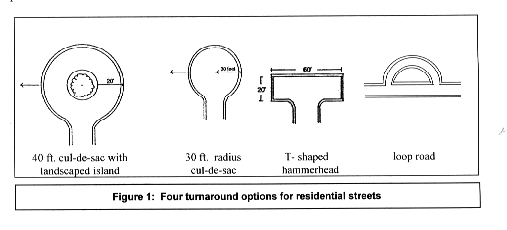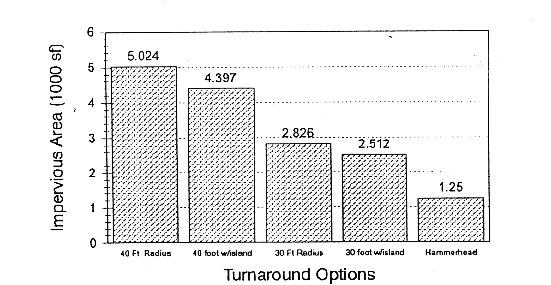
Better Site Design Fact Sheet: Alternative Turnarounds
Description
Alternative turnarounds are designs for end-of-street vehicle turnaround that replace cul-de-sacs and reduce the amount of impervious cover created in residential neighborhoods. Cul-de-sacs are local access streets with a closed circular end that allows for vehicle turnarounds. Many of these cul-de-sacs can have a radius of more than 40 feet. From a stormwater perspective, cul-de-sacs create a huge bulb of impervious cover, increasing the amount of stormwater runoff. For this reason, reducing the size of cul-de-sacs through the use of alternative turnarounds or eliminating them altogether can reduce the amount of impervious cover created at a site.
There are numerous alternatives to the traditional 40 foot cul-de-sac which create less impervious cover. These include reducing cul-de-sacs to 30 feet radius, hammerheads, loop roads and creating pervious islands in the middle.

Applicability
Alternative turnarounds can be applied in the design of residential, commercial and mixed use developments. Combined with alternative pavers, green parking, curb elimination and other techniques, the total reduction to site impervious cover can be dramatic, reducing the amount of stormwater runoff from the site. With proper designs, much of the remaining stormwater can be treated on site.
Implementation
Sufficient turn around area is a significant factor to consider in the design of cul-de-sacs. In particular, the types of vehicles entering into the cul-de-sac should be considered. Fire trucks, service vehicles and school buses are often cited as examples for increased turning radii. However, research shows that some fire trucks are designed for smaller turning radii. In addition, many new larger service vehicles are designed using a tri-axle and schools buses usually do not enter individual cul-de-sacs.
Implementation of alternative turnarounds will also have to address local regulations and marketing issues. Communities may have specific design criteria for cul-de-sacs and other alternative turnarounds. Also, cul-de-sacs are often featured as highly marketable and while alternative turnarounds can still capture the end of the street appeal, actual research on market preference is not widely known.
Limitations
Local regulations often dictate requirements for turnaround radii and some of the alternatives may not be allowed by local codes. In addition, marketing perceptions may also dictate designs, particularly in residential areas. While changing local codes is no small effort, by initiating a local site planning roundtable, communities can change some of these regulations through a cluster ordinance or through a collective effort to review local codes to promote better site design.
Maintenance Considerations
If islands are constructed as part of a turnaround, these areas will need to be maintained. Kept as a natural area, the costs could be minimal. Bioretention areas will also require maintenance. The other options create less asphalt to repave and maintenance will remain the same and cost less.
Effectiveness
In a comparison of several different turnaround options, hammerheads were found to create the least amount of impervious cover. Figure 2 summarizes the total impervious area for several different types of turnarounds.

Costs
Since alternative turnarounds reduce the amount of impervious cover created, construction savings can be an incentive (asphalt costs $.50 - $1.00 per square foot in materials alone). Bioretention is estimated at $6.40 per cubic foot and while it costs more than providing a naturally vegetated areas, it can help reduce overall stormwater costs.
References
American Society of Civil Engineers, National Association of Home Builders, and Urban Land Institute. Residential Streets (2nd edition). Urban Land Institute, Washington, DC. 1990.
Center for Watershed Protection. Better Site Design: A Handbook for Changing Development Rules in Your Community. Center for Watershed Protection, Inc., Ellicott City, MD. 1998.
Bucks County Planning Commission. Performance Streets: A Concept and Model Standards for Residential Streets. Bucks County Planning Commission, Doylestown, PA. 1980.
Institute of Transportation Engineers. Guidelines for Residential Subdivision Street Design. Institute of Transportation Engineers, Washington, DC. 1993.